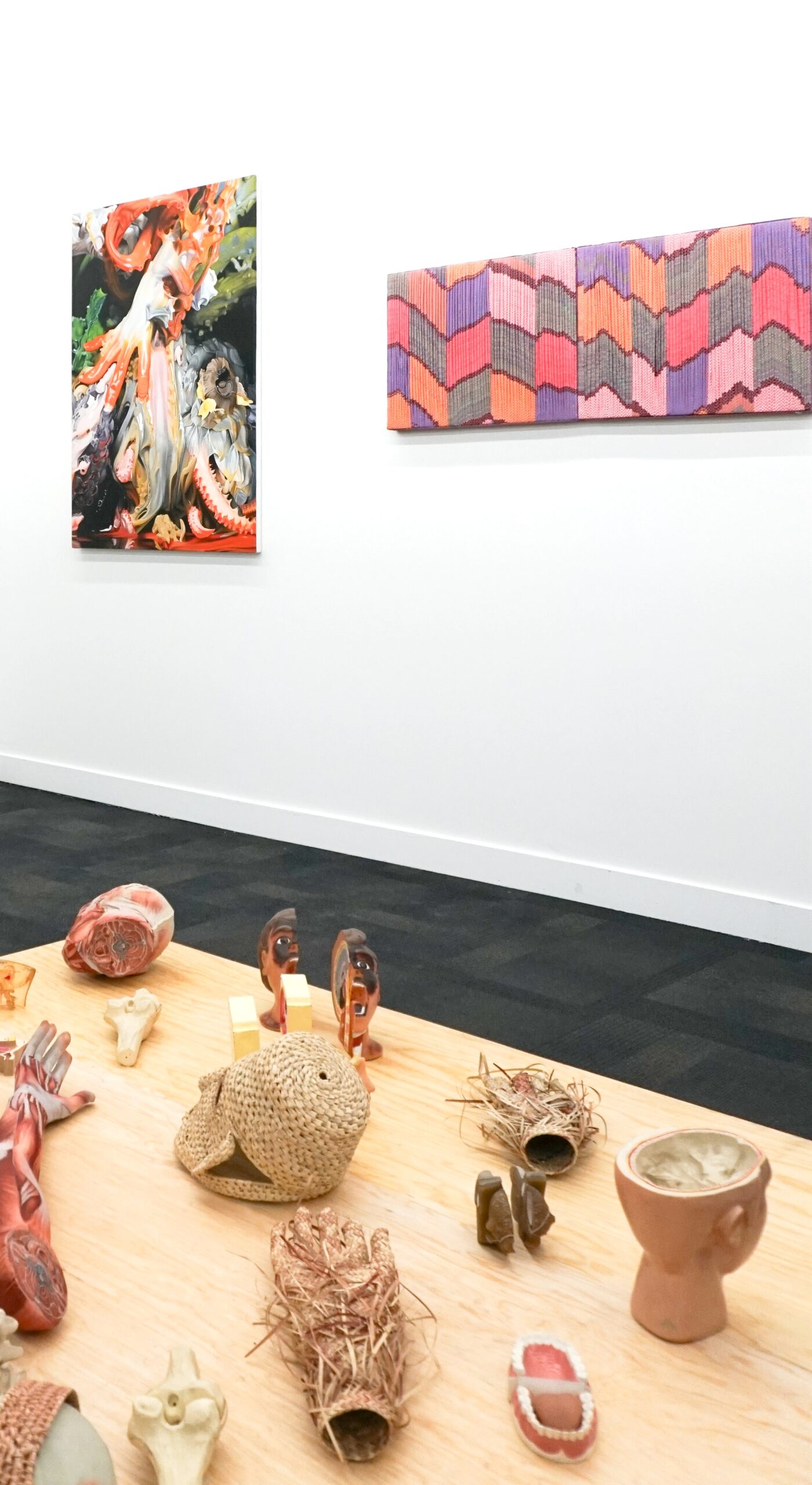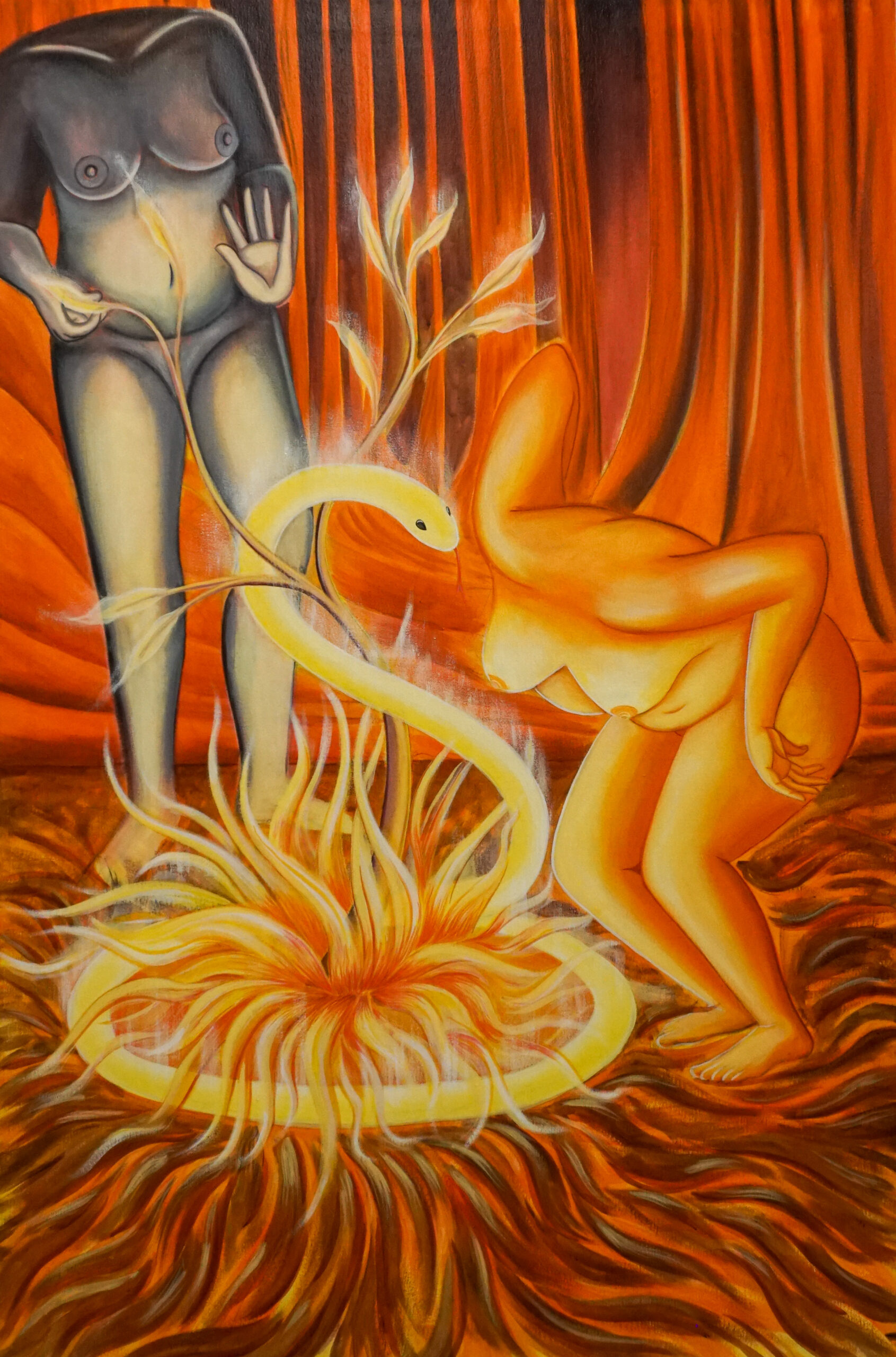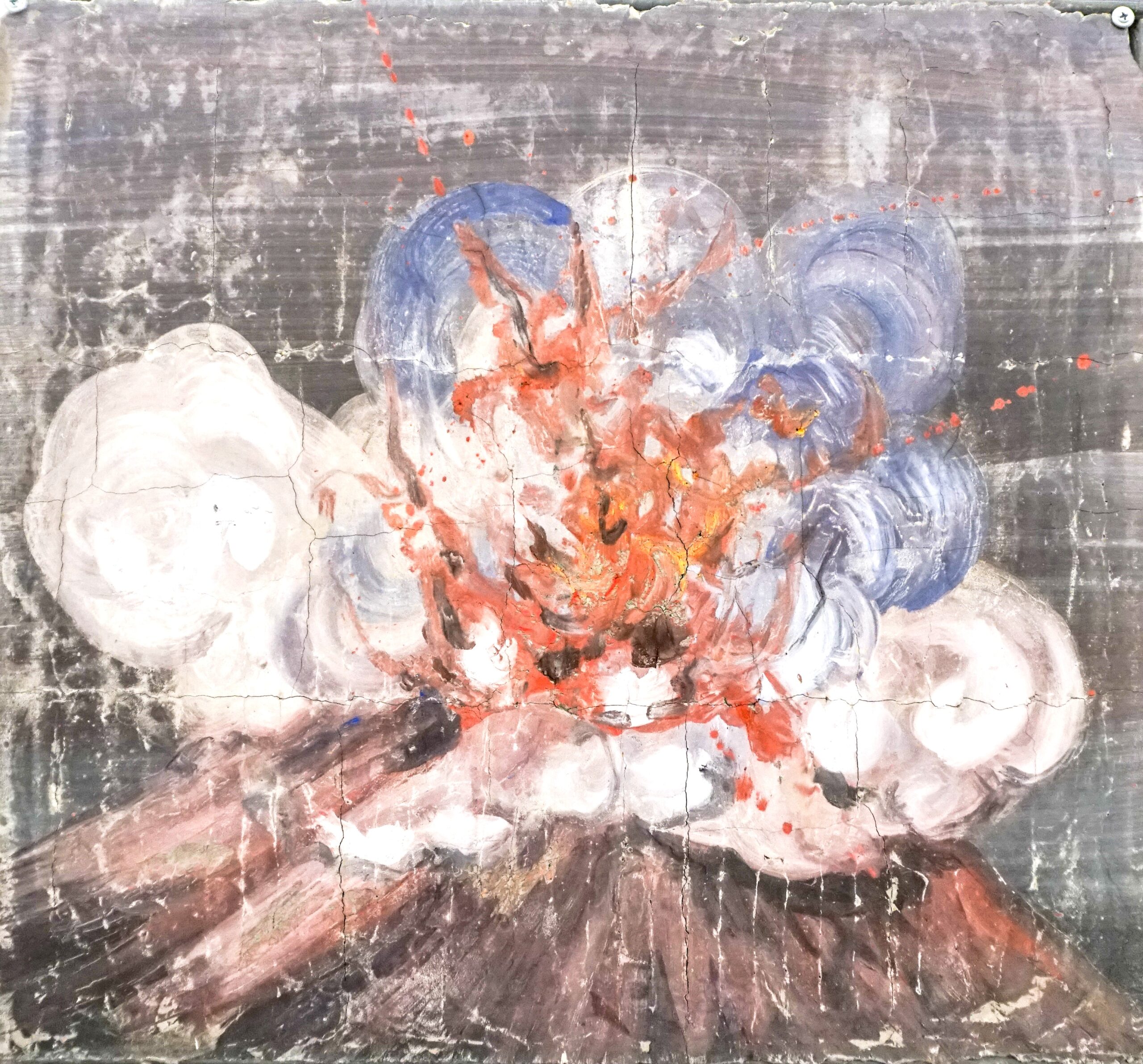Feria Material, Latin America’s most beloved contemporary art fair, is a destination for discovering new artists and galleries. It celebrates a decade with a special edition offering a thematic illustration showcasing its growth and evolution.
Maintaining its status as the fair for exploration, Feria Material presents a curated and coherent fair of experience, 356 exhibitors from 47 countries and 111 cities across two floors, and an exciting program of talks, screenings, performances, and other activities. Below, we share some of Elephant’s top picks from this edition.




L L A N O
LLANO is a Mexican platform focused on artists whose production results from long-term research related to science, history, technology, forgotten wisdom, and unforeseen communities. True to their program, LLANO presented a series of works by Lorena Ancona, Débora Delmar, Oscar Santillán, Enrique López Llamas, Mano Penalva, Erick Tlaseca, Tania Ximena, whose collective works discuss colonialism, environmental justice, and materialism. With the vibrant pinks and yellow of a flourishing English rose garden painted on metal panels made in collaboration with a traditional Mexican sign painter, Débora Delmar’s Liberty Roses series builds a bridge between her two homes and the tensions that lay beneath them through colonization, housing speculation, and nationalism. The images in Oscar Santillán’s Antimundo series of bold hyper-realistic paintings and sculptures of sci-fi-esque forms blending humans and creatures raise the tensions of what is truly “natural” leaning on the 18th century outlined in his Systema Naturae, an all-encompassing classification for everything on Earth to inform his work. Enrique López Llama’s muted mixed media assemblages works of impending doom scapes are fictionalized premonitions “latent in fear, concern, resignation and discontent due to the dizzying uncertainty of our times.” Mano Penalva’s colorful synthetic raffia bags are sourced in Brazil’s fields and manipulated into colorful landscapes, highlighting the global transit of goods and displacement interweaving various meanings of culture — the cultivation of the land, artistic traditions, and social values. Erick Tlaseca’s assemblage installation works using craft and small knick-knack objects found in Mexico City Street markets and the Mixtec community of San Pedro Jocotipac called Algún día llegará la noche (isla) are part of the conception of the figure of Xipe Tótec, a Mexica deity whose name in Nahuatl means “our flayed lord” and speak to discovering new ways to observe a body. Tania Ximena’s Eclíptica Solar (Solar Ecliptic) series, which constructs Creole corn and beans from the region of the volcanoes in the State of Mexico into landscapes based on her life in San Pedro Nexapa, State of Mexico, where the Tiemperos (Rainmaker) perform ceremonies to bless the seeds for their harvest the following year, exploring themes of environment, spirituality and our relationship to landscapes.

Deli Gallery
Deli Gallery is an independent community-oriented gallery presenting upcoming and emerging artists in New York and Mexico City seeking to support an artist regardless of their market value, academic background, exhibition history, race, sex, color, or orientation. For their booth at Feria Material, they presented historical and emotionally charged works by Lex Brown, Jose de Jesus Rodriguez‘, Alina Perez, and Abigail Lucien. Lex Brown’s poetic text-based gradient paintings and dreamscape drawings create narratives about spirituality in the information age. She is also the author of My Wet Hot Drone Summer, a sci-fi erotic novella that takes on surveillance and social justice. Jose de Jesus Rodriguez’s vivid, surreal mixed media paintings featuring fresco, chicken wire, and metal examine how personal and cultural narratives, such as catholic imagery and Chicanx iconography, challenge identity politics, otherness, and oversimplified and singular definitions of identity, especially visual identity. “Creating a dialogue that explores historical and cultural filters and the power of re-contextualizing iconography to open up new potentials.”

Alina Perez’s ghostly pastel and charcoal dreamscape invites us into her world of fluid memories, blurring reality, and personal histories. Abigail Lucien’s animated steel sculptures and drawings made of molten steel burns address themes of (be)longing, myth, and place. Working across sculpture, literature, and time-based media,” Lucien’s practice is auto-ethnographic: referencing found objects and familiar surroundings as a way to implicate the body’s relationship to material and place—interpreting concepts such as loss, love, and grief as a fluid procession rather than a state to reach or become.”

TAP Art Space
TAP Art Space is a commercial gallery located in Montréal, Canada. TAP began its journey as a project space, later transitioning into a commercial gallery. For its first participation in Material, TAP Art Space proposes a showcase of the works of three Montréal-based artists belonging to the Latin American diaspora: Raul Aguilar (MX), Diane Garcia Ramos (MX/US), and William Mora (COL). Their practices are bound together by a common desire to explore identity through the lens of cultural dualism. Raúl Aguilar’s cotton printed DTG prints resembling an airbrushed memorial style t-shirt “serve as a space to converge personal stories with contemporary metanarratives of individual determination, self-exploitation, immigration, masculinity, and hard work.” Diane García Ramos’s Glazed Stoneware sculptures depicting cultural and spiritual connotations weave a narrative shaped by their Mexican heritage. They seek to build “an archive of themes of impersonation and otherness experienced as part of the Latinx diaspora. Influenced by a queer and neurodivergent perspective, Ramos delves into the intersections of science fiction and prehistory, echoing paradoxical themes of transience and resilience”. William Mora’s work reflects the experience of growing up in two distant cultures: his practice reflects research carried out in these two cultural formations. Mora is also the founder of a visual art research studio, Memory Land Studio, which focuses on research into the art of visual communication, generating creative alternatives that are deposited in a fictional and natural world.


Swivel
Swivel Gallery’s focus is to work closely with artists on development and help guide and formulate their first exhibitions, careers, and opportunities thereafter. For this Feria Material edition, they present works by Maria Conejo, Alejandro García Contreras, and Isabella Mellado. It is a powerful ensemble of primordial energies, ancestral symbologies, and alternative spiritualities. Isabella Mellado’s warm emblazoned paintings connect to ancient legacies and spiritual iconography to her body and sexuality. Alejandro Garcia Contreras’ elaborate glazed ceramic pitchers and pewter snake vulvas explore topics and themes inspired by contemporary popular culture, Mexican folklore, myth, occultism, and religion. María Conejo’s artistic practice portrays the relationship with her own body, and it is nourished by ongoing research into the body, sexuality, and the iconography generated throughout history to represent and address these issues. Isabella Mellado’s colorful figurative works are modern interpretations of the tarot, continuing her exploration of the mystical spirit, queerness, and personal identity.

Campeche
Campeche is a contemporary art gallery in Mexico City, founded in 2020, presenting works by Yeni Mao, Alicia Ayanegui, Julieta Gil, Jou Morales, Javier Carro Temboury, Wazatta Fernández, and Abraham González Pacheco. The mixed media of concrete, sand, volcanic ashes, and metal works by Abraham Gonzalez Pacheco stem from an interest in Mexican History and its romanticization, as well as the lack of a historical archive of his hometown, San Simón el Alto. He imagines archeological fictions that originate from landscapes and the observation of accelerated transformation due to political and identity-related interests, institutional corruption, and centralization of population in the cities. Javier Carro Temboury’s blended pots and ceramics, sourced from flea markets and chance encounters, are transformed into sculptural works that speak to contrasting times and places, craftsmanship, and understanding the culture of others. Alicia Ayanegui’s intimate still lives reflect the meaning of stillness and emptiness and provide a glimpse into her living space and life. Yeni Mao’s fanciful stoneware sculptures and institutions depict his personal interpretations of mythical subjects, which have a narrative undertone and are frequently autobiographical, regarding the Canadian Chinese artist’s transnational background. Interlaced and recurrent themes and strategies in Mao’s practice draw upon notions of displacement and migration, the fragmented and sexualized body, and its relationship to the built environment. Jou Morales’s whimsical paintings of deformed and palpitating creatures.


That “develops throughout scenes that are approximations to elements of the composition of other paintings in the series, which unfold without a clear beginning or end. “Julieta Gil’s floral collages on aluminum sheets explore relationships between space, memory, and materiality; documenting sites from routine walks, she imposes narratives confronting collective forms of telling and remembering.

Charlie James Gallery
Charlie James Galleries’ ethos asserts that art should engage with the time of its making and is known for platforming work of significant political and cultural engagement. They continued with this ethos with their solo presentation of Narsiso Martinez. Martinez’s figurative drawings on unconventional materials like produce boxes, grocery shopping bags, and plastic produce materials depicting farm workers are a powerful statement on the life of laborers around the country. “In a style informed by 1930s-era Social Realism and heightened through the use of found materials, Martinez makes visible the difficult labor and onerous conditions of the “American farmworker,” itself a compromised piece of language owing to the industry’s conspicuous use of undocumented workers.”
Written by Amber Smith
Feria Material is open to the public from February 9th to February 12th
find out more





